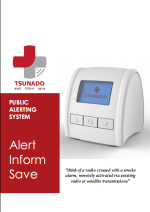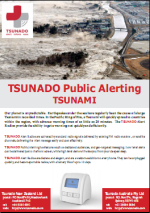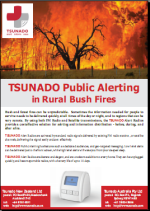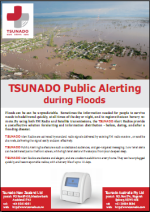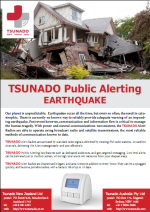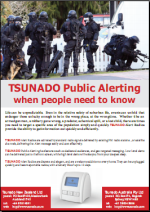-
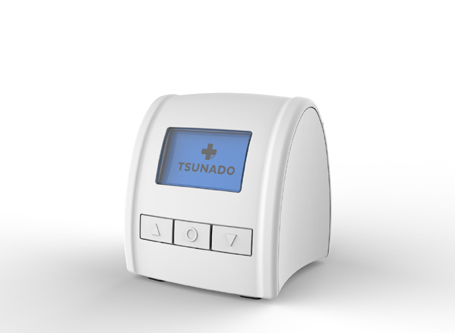
Introduction
Tsunado is a system to distribute Alerts in a Civil Emergency, such as Tsunami, Fire, Flood, Chemical spill, etc. It support graduated alerting, Possible, Probable, and Certain, chosen by the user. -

Alerts
Tsunado Alert radios contain a high intensity alarm, similar to that in a smoke alarm, to get attention any time day or night -

Information
Central to the Tsunado Alert Radio is a radio receiver that can deliver the radio signal through a speaker, informing the public of what to do.
- 1
- 2
- 3
Front Page News
-
Critique of Tauranga City Council Policy
-
Another Quake Hits New Zealand
-
Article in Tauranga Weekend Sun Newspaper
-
Earthquake hits East Cape in New Zealand
-
Callaghan-funded tech gives early warning when disaster looms
-
Innovative Partnership in Emergency Management and Public Alerting
-
NZ technology gives better warnings of disasters
-
Tsunado technology made possible with government funding
-
TSUNADO Trial in Waihi
White Papers
The Three States of Emergency Public Alerting
Communications related to disaster events are important to save lives. This Paper considers the three types of communication that contribute to an effective strategy to ensure that when disaster strikes, there is minimisation of damage to life and property.
A Comparison Between Broadcast Radio and Cellular Technologies for Emergency Public Alerting
TSUNADO New Zealand Limited (aka DIWA) has developed a system for nationwide Public Alerting based on Broadcast Radio technologies. The decision to use Broadcast Radio and Satellite systems as the primary communication channel, as opposed to cellular and internet based technologies, is outlined in this White paper.
Waking a Sleeper
TSUNADOAlert Radios are provided with an internal alert device similar to smoke alarms. This White paper outlines how different and effective the TSUNADO alert is in waking a deep sleeper.
ALERT Get Attention
The prime function for Tsunado alarms is to get the owner's attention, anytime day or night.
Read MoreINFORM Provide Information
The secondary feature, but by no less important, is to inform the owner of what to do.
Read MoreSave Keep you Safe
By delivering alerts quickly and informing owners of what to do, Tsunado saves lives.
Read MoreTsunado technology made possible with government funding
A new life-saving technology has been developed with the help of New Zealand government funding. Developed and manufactured in New Zealand with the assistance of Callaghan Innovation, this new product is now on its way to be commercialised for the use in offices and homes. The Tsunado was developed by New Zealand company Disaster Warning Systems Limited (DIWA).
$260,000 in government funding supports disaster management technology
During the stages of research and development, Callaghan Innovation provided a total of $260,000 in funding to DIWA. Not only did the government ogranisation provide funding, but also served as a mentor to the company by providing technical and marketing solutions and expanding their network of useful sources. The Tsunado product provides users with improved information and alerts about natural disasters. This product is a compact alert radio unit with a plug-in design. When a natural disaster occurs, such as an earthquake or volcanic eruption, the radio sounds an alarm then self-tunes into the nation's Civil Defense radio broadcast. According to Tsunado inventor Gary Benner, this idea occurred to him when he heard news of the 2004 earthquake and tsunami and simultaneously had his smoke alarm set off.
Tsunado technology now ready for purchase in New Zealand
Natural disaster emergencies can now be dealt with in a more organised manner with the assistance of this new government-funded technology. The Tsunado is now readily available to be pre-purchased on the company's website. This disaster management technology is already showing strong potential for exporting overseas. The Tsunado is also battery powered — which is useful in power outage situations — therefore allowing authorities to communicate important information to people in need. By providing funding for the development of such technology, the government continues to support innovation and protect individuals from natural disasters.
